Have you been wanting to sell on Amazon but don’t know how to get started or don’t yet have the budget to launch a private label product? One great method to get started is through retail arbitrage. Broadly speaking, arbitrage is the practice of taking advantage of a price difference between two or more markets, or, in other words, reselling.
You can start selling through retail arbitrage with as little or as much money as you’re comfortable with — you can even do it without stepping foot inside a store!
Keep reading to learn about retail arbitrage, or check out this video for a step-by-step overview of how to get started.
- What is retail arbitrage?
- Pros and cons of retail arbitrage
- How to get started with retail arbitrage
- How to source retail arbitrage products to resell on Amazon
- How to list your arbitrage products on Amazon
- How to create your FBA shipment
Want to learn more about selling on Amazon? Check out our complete guide.
What is retail arbitrage?
Arbitrage is the practice of taking advantage of a price difference between two or more markets, or, in other words, reselling.
An example of this would be finding a product at Walmart that sells for $5, purchasing that product, and then reselling it on Amazon for $20. Pretty cool, right?
Some sellers also buy products they find online, which is known as online arbitrage, and the process is the same: buy low, sell high (on Amazon).
READ MORE | How to Make Money with Online Arbitrage in 2024
Yes, retail arbitrage is legal. According to the first-sale doctrine, once you purchase a product legally, you then have the right to resell that product, as long as it is sold in an unchanged condition. So if you buy and sell it as new, the product must be sold in new condition.
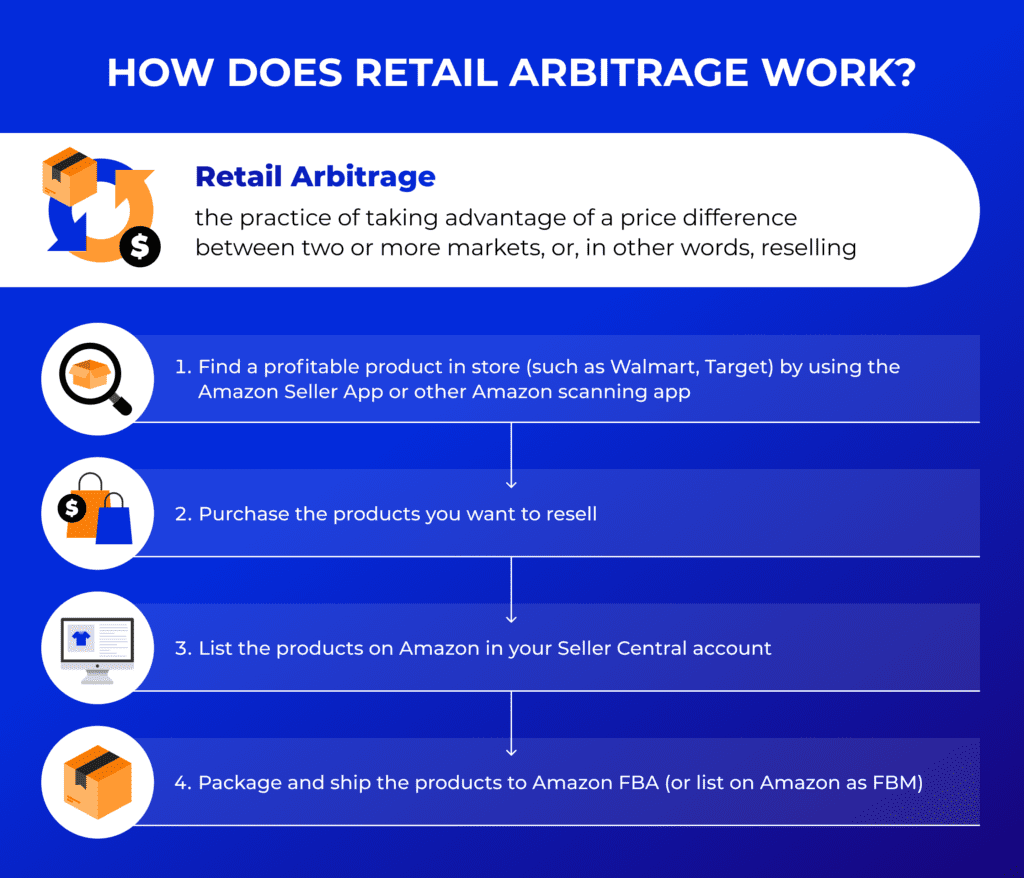
How does retail arbitrage compare to other business models on Amazon?
- Private label is when you create your own product label/brand, generally by modifying an existing product in the market. It’s the most common method of selling on Amazon and can be incredibly profitable, but most sellers need some capital to get started.
- Wholesale is when you buy products in bulk directly from a brand or from distributors (not retail stores) to sell on Amazon, which also requires start-up money. Wholesale is a more sustainable business model as you can replace orders every month and you are an authorized reseller, meaning you don’t have to worry so much about inauthentic claims.
- Dropshipping is when you buy products directly from a manufacturer who fulfills the order and ships directly to the customer.
- Handmade is the process by which you create or craft your own products to sell on Amazon.
READ MORE | How Much Money do Amazon Sellers Make?
Pros and cons of retail arbitrage
Doing retail arbitrage on Amazon is a great way to earn extra income on the side or even to replace your current income. Let’s go over some pros of retail arbitrage.
Pros
- Lower cost to start. According to Jungle Scout’s study of more than 1,000 Amazon sellers, 10% of those doing arbitrage were able to launch Amazon businesses with less than $500, and about 26% did so for less than $1,000. By contrast, 76% of private label sellers spent $1,000 or more to launch.
- Faster to start. 25% of retail arbitrage sellers said they were able to launch Amazon businesses in less than one month. Only 14% of private label sellers said the same.
- Easier to find products to sell. Sellers have many options when it comes to finding products to resell on Amazon. Compared to private label, finding profitable products to resell on Amazon from retail is typically easier than doing product research for a new product launch.
- No launching a new product. The biggest benefit to retail arbitrage is that you don’t need to launch a brand new product on Amazon—you will be selling existing products that already sell well on the platform. When you launch a new product, you must spend a lot on advertising and marketing to get the ball rolling.
While there are a lot of pros to doing retail arbitrage, let’s go over some of the cons when following this business model.
Cons:
- Time-consuming. In order to keep your business running, you must be sourcing products on a weekly basis. This could mean driving from store to store and searching for products to resell, which can be tiring and time-consuming.
- Not always consistent. One week you may find a great product at a profitable price point, but it doesn’t mean you’ll always be able to source the same product. You may not be able to find it again, or the store you bought it from could raise the price.
- Price wars. One of the downsides of retail arbitrage is that you’re constantly competing for the Buy Box with other resellers. A listing you are selling on could have 10+ other sellers on the listing, all competing to get the sale. This is why some RA sellers pivot to wholesale or private labels.
- Counterfeit claims. Since you will be reselling other brands’ products, you may come across a counterfeit claim once in a while from a brand that doesn’t want resellers. A solution to this would be to stop selling that particular brand and focus on smaller brands or products that seem to have other resellers.
Is Amazon retail arbitrage worth it?
Essentially, if you don’t already have a product to sell or have money to buy products at scale, arbitrage is a great, low-risk method of selling on Amazon.
On the other hand, if you start selling arbitrage, you can expand your strategy to other sales methods:
- 36% of retail arbitrage sellers also run a wholesale business
- 21% also sell private label
- 22% also have a dropshipping business
- 11% also sell handmade products
So how does it all work?
How to get started with retail arbitrage
Before you can find profitable products to resell on Amazon, you need to create an Amazon seller account, download a product scanning app, and choose your fulfillment method.
1. Create your Amazon Seller account
If you don’t yet have an Amazon Seller account, be sure to complete this step first, as it takes a week or so to get your seller account approved by Amazon.
Follow our step-by-step guide on How to Create an Amazon Seller account.
2. Choose your fulfillment method
Ultimately, you’ll also want to decide whether to fulfill your products yourself with Amazon’s Fulfillment by Merchant or FBM, or have Amazon handle the packing, shipping, and customer service with Fulfillment by Amazon or FBA. Hint: you can do both!
READ MORE | Amazon FBA vs FBM Comparison Guide
3. Download a scanner app
While different tools and software are available that will help you find products to resell, the only thing you really need is the Amazon Seller app, which is free to use with your Amazon seller account.
This is the app you will use to scan products when in retail stores. Scanning products with the Amazon seller app will show you various listings, the sales rank, whether you are allowed to sell that certain product, and allow you to enter your buy cost to determine profitability (after all of Amazon’s fees). You can even list products for sale directly from the app.
If you don’t currently have this app on your phone, go to the app store and search “Amazon Seller.” Once you have the app downloaded, sign in to your Amazon seller account and you’re ready to go!
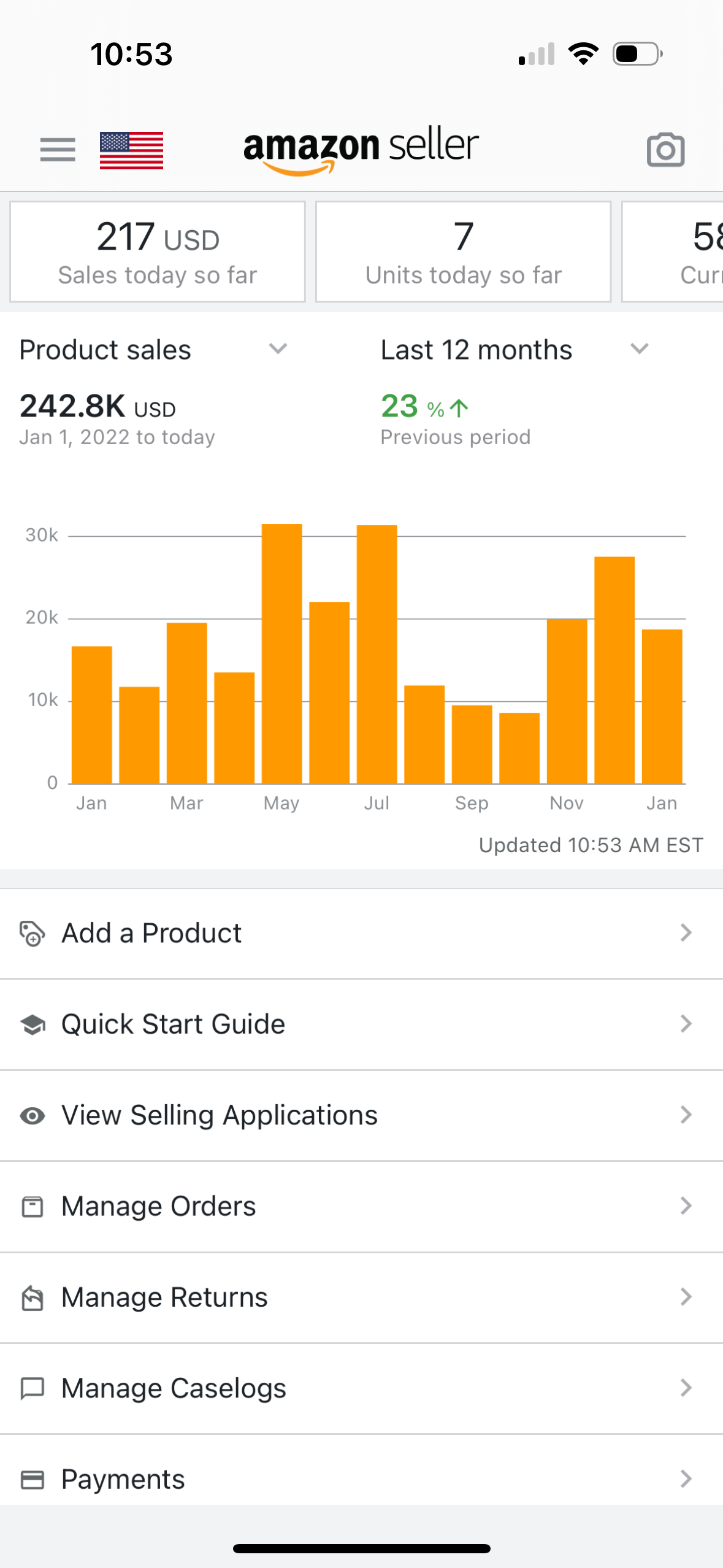
The Amazon seller app allows you to:
- Monitor your sales
- Answer customer messages
- Manage orders and returns
- Scan product barcodes
- Check a product’s profitability
- List products on Amazon
- And much more
4. Leverage ecommerce intelligence tools
Another tool that makes finding profitable products easier and is useful for both retail and online arbitrage is Jungle Scout’s Extension.
Jungle Scout Extension allows you to get a quick snapshot of how well a certain product sells on Amazon at the click of a button. You simply enable the Chrome extension as you’re browsing a listing on Amazon, and you can view price history, sales history, as well as a product’s profitability.

To get a better picture of how consistently this product sells, click on the number to see historical monthly sales (“Mo. Sales”).
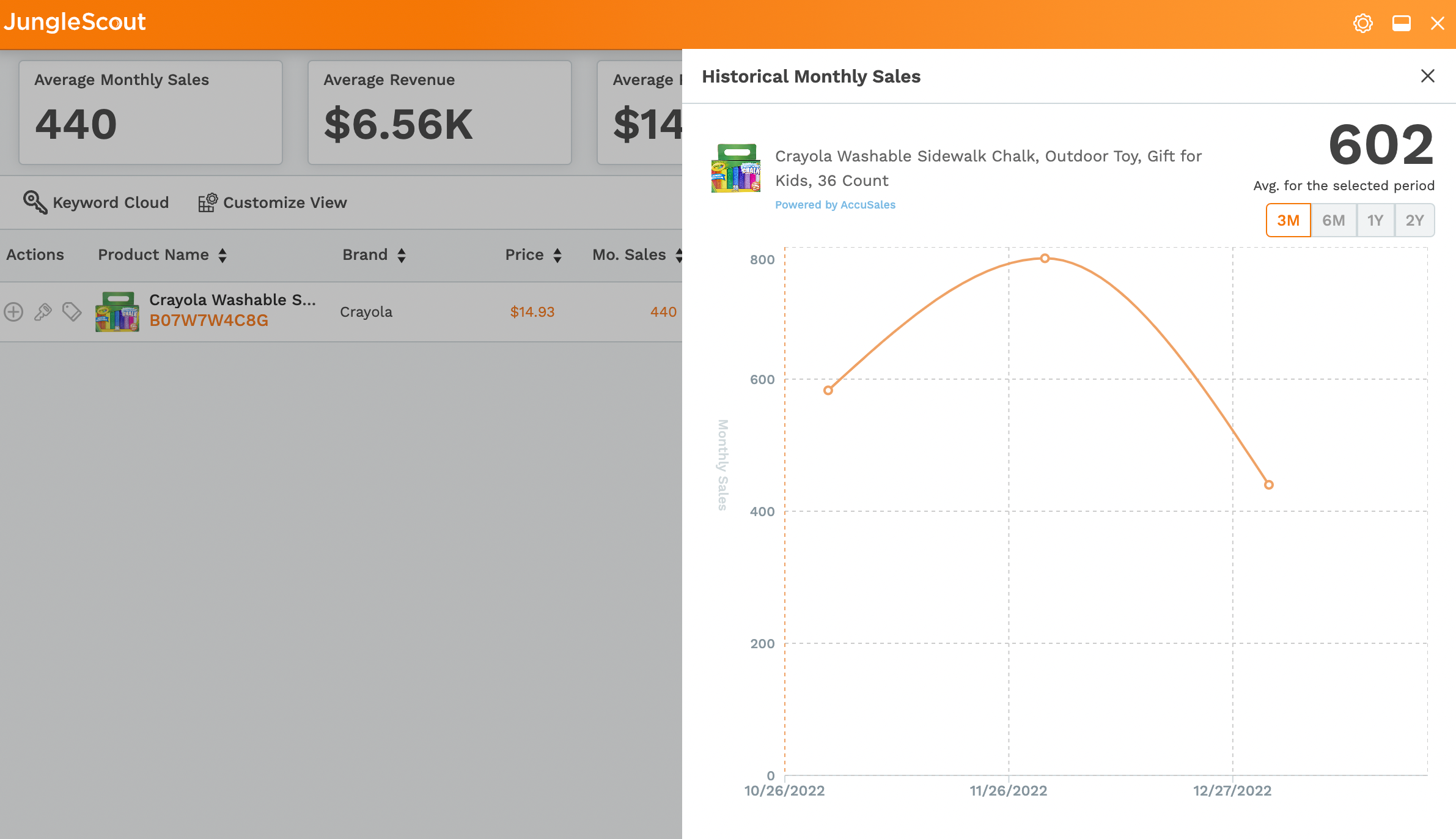
This graph will show you sales over time, which is a very important metric to look at, as it will tell you if a product sells consistently or not.
As you can see in the graph above, the sales steadily increased during Q4, then dropped off in January – showing that this may not be the best time of year to sell this product. This is why it is very important to make decisions based on historical data and not the current sales rank.
The Extension also features a Historical Trend data chart located in the embedded section on a product detail page. Sellers are now able to see historical data points such as Buy Box price, New lowest price, BSR, Amazon’s price, and more.
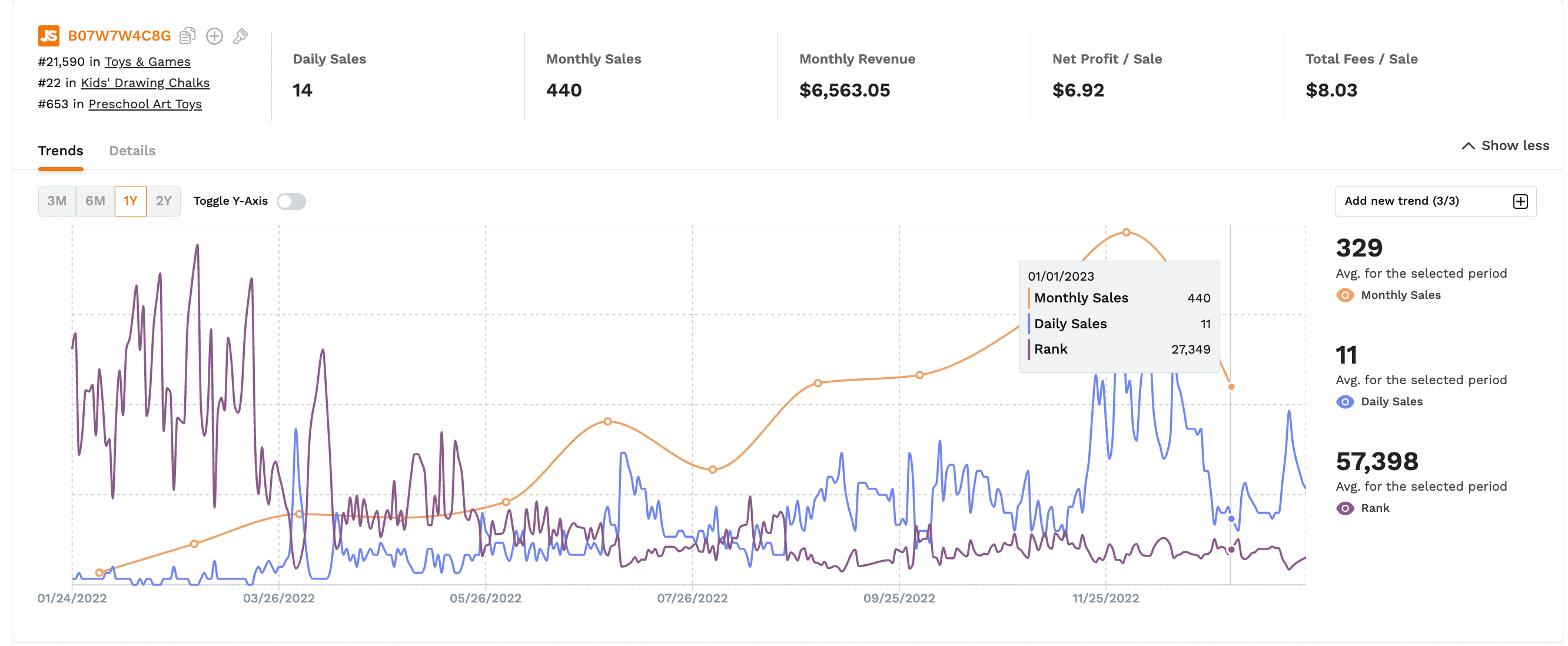
Sellers are able to choose the data points they would like to see about the product and sellers are allowed to filter between 3, 6, 12, and 24 months.
With these easily accessible data points, sellers can better understand an ASIN’s performance to make more informed decisions.
Click the link below to start leveraging Jungle Scout’s powerful ecommerce intelligence tools.”
How to source retail arbitrage products to resell on Amazon
Once you have the Amazon seller app, you can get started looking for some products! A great place to start is at a local “big box” retailer or discount store.
Stores to source products to resell on Amazon:
- Walmart
- Target
- Kohl’s
- Marshalls
- Ross
- TJ Maxx
- Homegoods
- Dick’s Sporting Goods
- Dollar General or other dollar stores
- CVS/Walgreens/Rite Aid or other convenience stores
- Burlington
- Grocery stores
Tip: You can use a website called Brickseek to check in-store deals as well as the stock available at stores in your area.
Types of products to resell on Amazon:
The 10 most popular Amazon product categories that arbitrage sellers sell in include:
- Beauty & Personal Care: 37% of arbitrage sellers sell here
- Clothing, Shoes & Jewelry: 34%
- Home & Kitchen: 31%
- Arts, Crafts & Sewing: 29%
- Toys & Games: 27%
- Electronics: 25%
- Grocery & Gourmet Food: 25%
- Books: 23%
- Health, Household & Baby Care: 22%
- Office Products: 21%
Once you’ve picked a store and category, it’s time to start finding products!
Step 1: Go into a retail store and start scanning products
It may be intimidating and awkward to just walk into a retail store and begin scanning items with your phone, but remember that everyone starts somewhere!
Using the Amazon seller app, hit the camera button in the top right corner.
This will look just like you are using your camera on your phone. You can use the camera in the app to scan the product packaging and search by image or to scan a barcode.
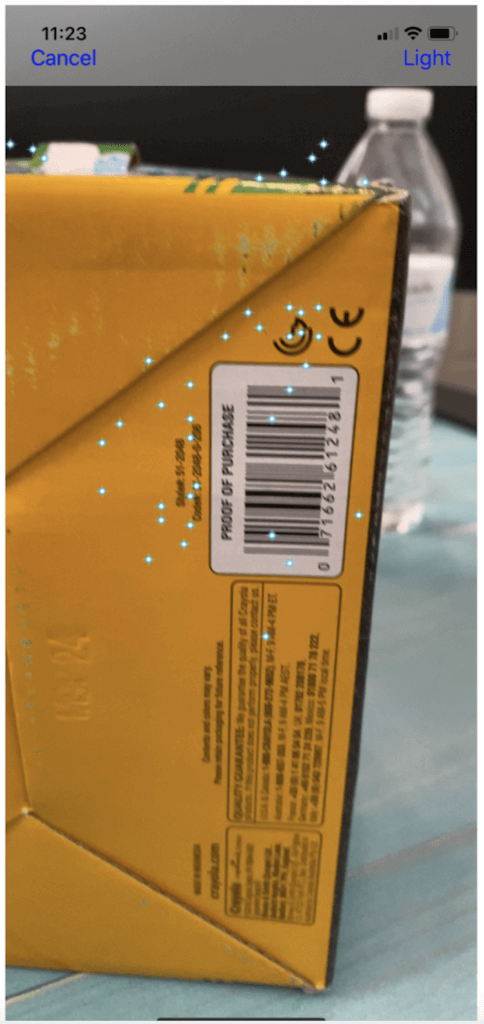
Step 2: Go through the search results and choose the correct listing
It is not uncommon when scanning products using the Amazon seller app to see multiple results. You’ll notice that many products have either duplicate listings or some listings will be a 2-pack, 3-pack, etc.
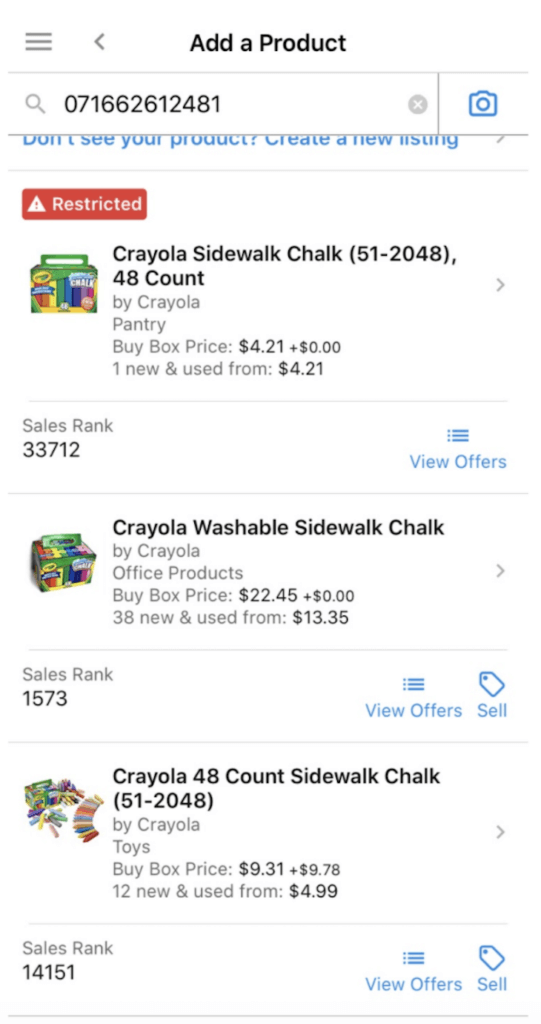
In this example, I scanned “Crayola Washable Sidewalk Chalk 48-Count,” and it brought up three results.
On the first result, you can see right away that it is restricted. If you click on that first option, the next screen will read “You cannot sell this product in new condition.” So now I know to stay away from that listing.
In the second option, I can see the current Buy Box price is $22.45, so I am going to click on that listing.
Step 3: Analyze the data
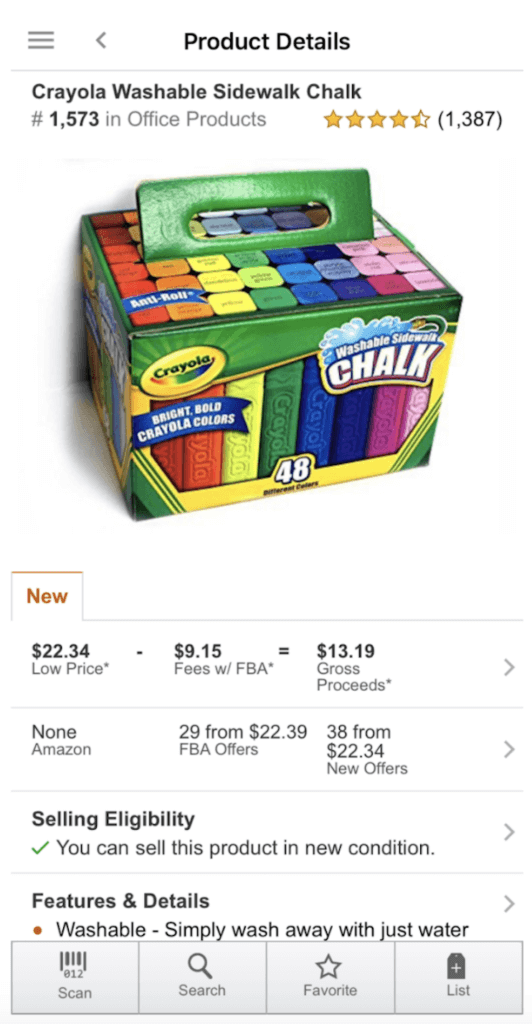
Things you should be looking at on this screen:
- Features & Details. Click on this first so you know exactly what this listing is for — one box, two boxes, etc. After looking at the details, we know this listing is for one box of 48 pieces of chalk.
- Sales Rank. You can see this right under the title as well as in the Features & Details section. The Best Sellers Rank is different for each category on Amazon but a general rule of thumb is to look for products under 100,000 sales rank. The lower the number, the more it sells. So for our example, a sales rank of 1,573 is very good for Office Products. Keep in mind that this number can be misleading as it may indicate a random burst of sales that day. This is why it’s important to use a tool like the Jungle Scout Extension to see if that rank is consistent. You can also check the estimated number of monthly sales based on sales rank for free using the Jungle Scout Sales Estimator.
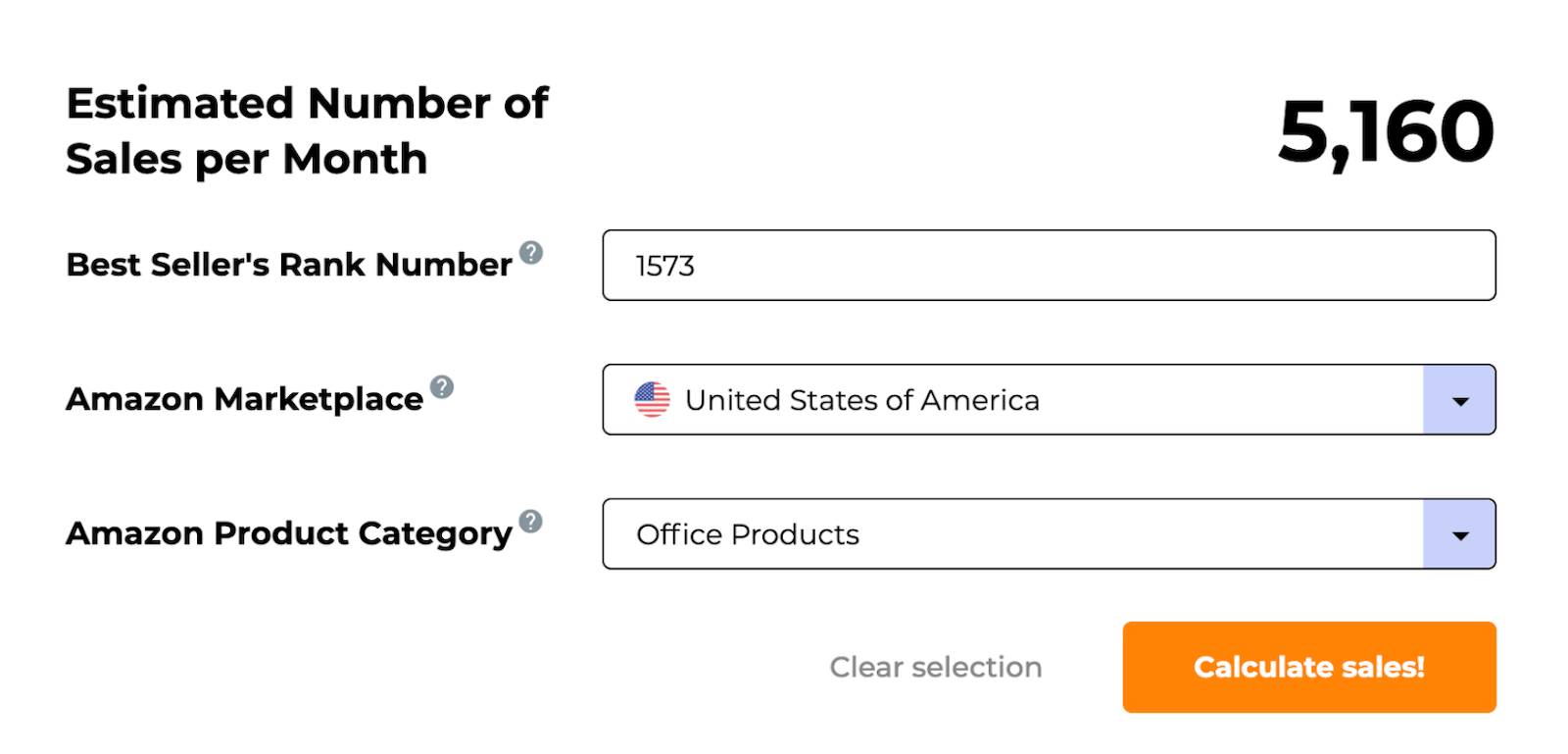
- Sellers on the listing. In the second row under “New,” you will see if Amazon is on the listing, the number of FBA sellers, and the total number of sellers, including FBM. I try to avoid all listings that Amazon is on because it doesn’t always share the Buy Box with third-party sellers, which may get you stuck with inventory you cannot sell.
There are a lot of FBA sellers on this listing, but with such a low sales rank, this product would still be a good buy as long as it is profitable.
- Price and gross proceeds. The most important piece of the puzzle: can you now sell the product at a profitable price? If you click on the pricing section, you will be able to input your buy cost and Amazon will break down all of the fees so you can decide whether or not you should buy this product.
In the app, input your buy cost and it will automatically show you the potential profit.
For this particular product, I am able to purchase it for $5.74. Based on the current selling price minus FBA fees and buy cost, my profit would be $7.45. That is over a 100% ROI, so I would buy this product!
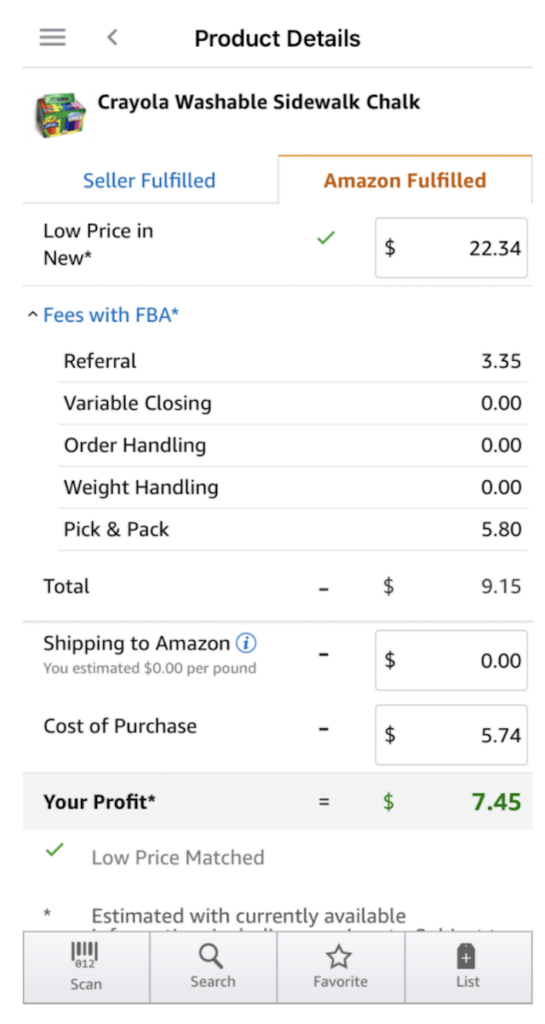
Step 4: Decide how many units to buy
Your decision about how many units of a product to buy (if there are a lot of them available) is based on your own personal risk tolerance. For the example used above, there were 22 FBA sellers with an estimated 5,000 monthly sales based on the sales rank. To figure out how many units you can potentially sell in a month, divide the number of monthly sales by the number of FBA sellers.
5,000/22 = 227
This means you could potentially sell more than 200 units of this product per month. Of course, this can vary depending on if new sellers hop onto the listing, if the sales rank drops, or if the Buy Box price decreases.
If you are new to retail arbitrage or selling on Amazon in general, I suggest starting with a small amount of units to validate the product. For the above sidewalk chalk example, consider starting with 5 or 10 units and see how it sells.
Step 5: Determine your target ROI/profit margin
What is ROI?
Your return on investment, or ROI, is the amount of money you make back that (ideally) exceeds the amount you put into your business venture.
For example, if you purchase a product for $10 and your gross proceeds after a sale were $12, your ROI is the difference (profit: $2) divided by your investment, or 20%.
Obviously, you want to aim for the highest ROI possible, not only so you make more money per sale, but so there is some wiggle room in case the Buy Box price decreases.
The minimum ROI you accept will vary depending on your own preferences. Some sellers are comfortable with making a small ROI (this is subjective, but say 20%) as long as they sell the product within a month, while other sellers want to make at least 50% ROI for it to be worth it.
Online arbitrage
Online arbitrage works essentially the same way retail arbitrage does, except you’ll search for products on retailer websites instead of in-store aisles. The best part about online arbitrage is that you can do it without leaving your house!
There are a few paid software and tools out there that can help you automatically scan through thousands of products but you can still find profitable products going through ecommerce stores manually.
READ MORE | How to Make Money with Online Arbitrage in 2024
Amazon arbitrage tips:
Follow these tips to increase your chances of success when doing retail arbitrage on Amazon.
1. Follow trends and sell seasonal products
While you could go into a store or look around online for products that might be profitable to resell on Amazon, you could also do some research and think ahead for certain types of products you’d like to find.
One thing to consider is seasonality. Try to figure out what products are currently or soon-to-be trending or products that sell more during a certain time of year.
For example, toys during the holiday season or inflatable pools or floats during the summer are extremely popular (and profitable). Since the demand is so high during those times, supply tends to diminish very quickly in retail stores, which translates into an increased selling price online.
During the summer of 2020, you could purchase an inflatable pool at Walmart for $20 and resell it on Amazon for $80. And yes, customers will purchase a product at that much-higher price point if they cannot find it in-store and really want the item.
If you stay on top of trends and current events like these, you will be on your way to having a profitable Amazon reselling business.
2. Sell discontinued products for massive profits
Has there ever been a product that you absolutely loved but then for whatever reason, the brand decided to discontinue it? We’ve all been there, and we know we’d pay a premium to get those products back. Some consumers are willing to pay extraordinary amounts of money for products that are seemingly impossible to find.
You may be thinking, if a product is discontinued, then how can I still find it in-store? Some discontinued products are still circulating in the market and will randomly pop up in retail stores, discount stores, grocery stores, etc. It is just up to you to be in the right place at the right time.
Tips on finding discontinued products:
- Shop in local stores, not a big box retailer such as Walmart. A “mom-and-pop” shop is more likely to carry these random, discontinued items.
- Look for items that just look old. I know that sounds odd, but you may spot some products with labels that look outdated, faded, or even dusty.
- Look for items labeled “refills.” There are lots of products in the cleaning category that require refill packs to continue using the product. For whatever reason, lots of the refills become discontinued, but people still really love using them.
- Go on eBay and search for “discontinued.” Then filter by sold listings only. This will show you all of the products labeled “discontinued” that have recently sold on eBay.
3. Additional tips and strategies when doing arbitrage:
- Be patient. Going into retail stores and scanning item after item can become very exhausting. It also becomes frustrating when you aren’t finding any profitable products. Just keep going! Eventually, you will find products that will make you money on Amazon.
- Base your buying decisions on data. Use the Amazon seller app and the Jungle Scout Extension. You don’t want to buy something that you won’t be able to sell.
- Prices can change in an instant if another seller “tanks the price.” Meaning the product you purchase may not be profitable anymore. This is why you need to check price history as well.
- Start small to get used to the process. Before going all-in and spending tons of money on products to resell on Amazon, start with a small quantity so you can get a better understanding of sourcing, listing, shipping, pricing, and more.
How to list your arbitrage products on Amazon
The next step in reselling products on Amazon is how to actually list your product for sale. Since this is not a private label product, you will not be creating a brand new listing. You are simply going to find the current listing you want to sell on and add that ASIN to your catalog in Seller Central.
This means that, unlike private label where you will be the only seller of your product, you will end up sharing the Buy Box with multiple sellers. If you find a product that sells roughly 300x a month, know that you will not receive all 300 of those sales if there are other sellers on the listing.
There are a couple of ways you can do this, so let’s walk through each one.
Option 1: List the product from the Amazon seller app
After you scan a product in the seller app, you have the option to list the product as Fulfilled by Merchant (FBM) or Fulfilled by Amazon (FBA). If listing as FBM, you can choose to add in your available inventory in the app so your offer will immediately be available for sale.
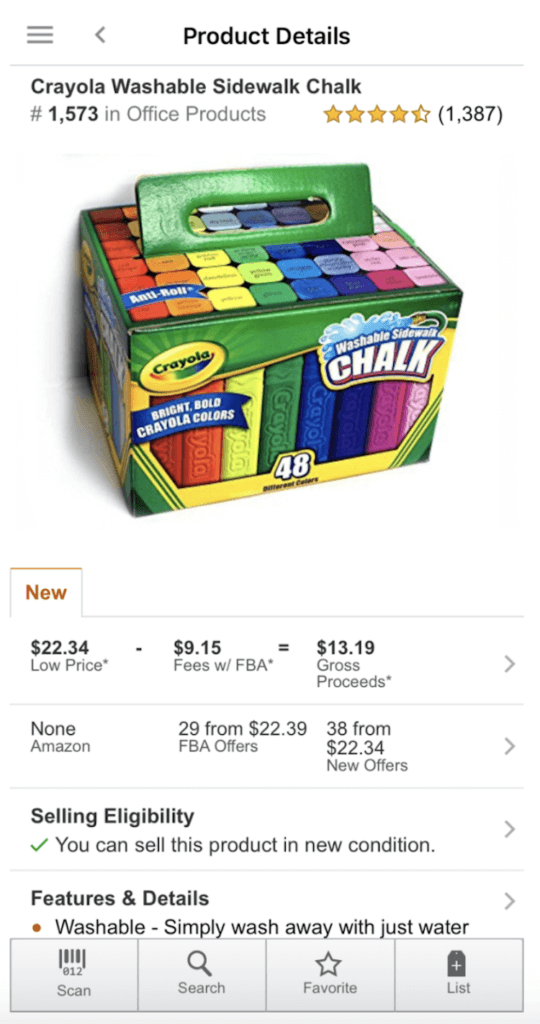
In the bottom right-hand corner, click “List.” You will see condition, price, SKU, and fulfillment channel.
For condition choose “New.”
The pricing section can get tricky so please pay attention to this part. Amazon will have the option to “Match Low Price.” This may sound like what you want to do but do not choose this option without checking the FBA prices first.
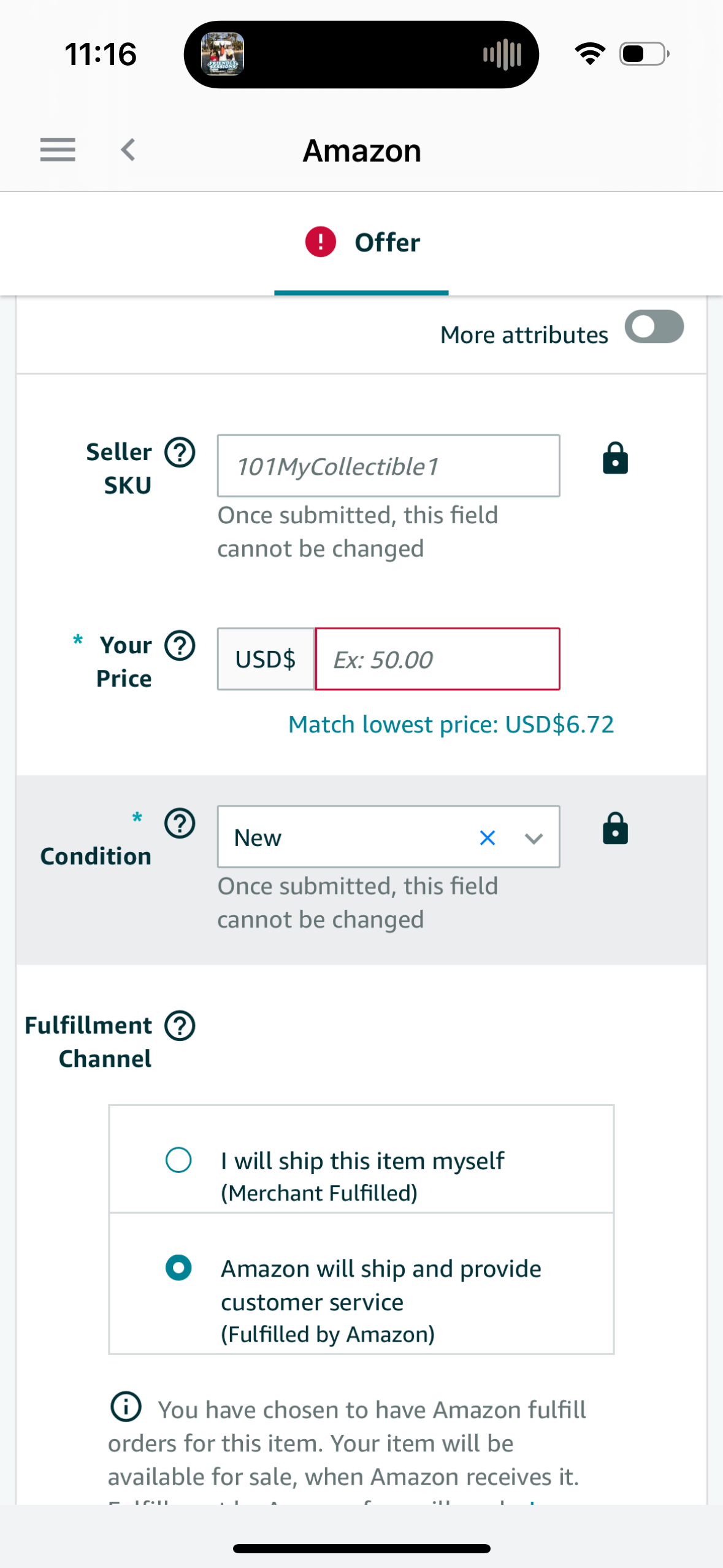
Amazon is showing me the lowest price for New is $6.72. If we choose this price, the product would not be profitable.
However, that is the lowest price for an FBM offer, not an FBA offer. If you look back at the pricing section, you will see the lowest FBA price is $22.39. That is the lowest price you want to list at. If you go lower, you will be the seller who tanks the price and ruins the profitability.
I usually set my price a couple of dollars higher than the current Buy Box price. You can always adjust when your inventory arrives at an FBA warehouse and is ready to sell.
Tip: To help you make more profitable pricing decisions on your products, you can add in your own custom seller stock-keeping unit (SKU). If you leave it blank, it’s not a big deal since Amazon will set one for you.
But I suggest formatting your SKU so you know exactly what you paid for the product, where you bought it, and your breakeven price.
For example, if I bought the chalk at Walmart for $5.75 and my breakeven price is $14.00, I would set up my SKU as follows:
WM_5.75_BE14
This tells me: I bought it at Walmart for $5.75 and my breakeven price is $14. So as long as I sell this product for over $14, I am not losing money.
Next is Fulfillment Channel. If you choose “I will ship this item myself,” you are choosing FBM and can add your available inventory in the app. If you choose “Amazon will ship and provide customer service,” you are choosing FBA and will need to set up your shipment in Seller Central (not in the app.)
When you choose the FBA option, the app will automatically add the listing into Seller Central for you. All you need to do then is create an FBA shipment so your listing offer can go live.
Option 2: List in Seller Central on your desktop/laptop
This is the easier way to list your retail arbitrage products on Amazon.
First, I will find the exact listing I want to sell on. Once you do that, copy the ASIN and paste it into Seller Central.
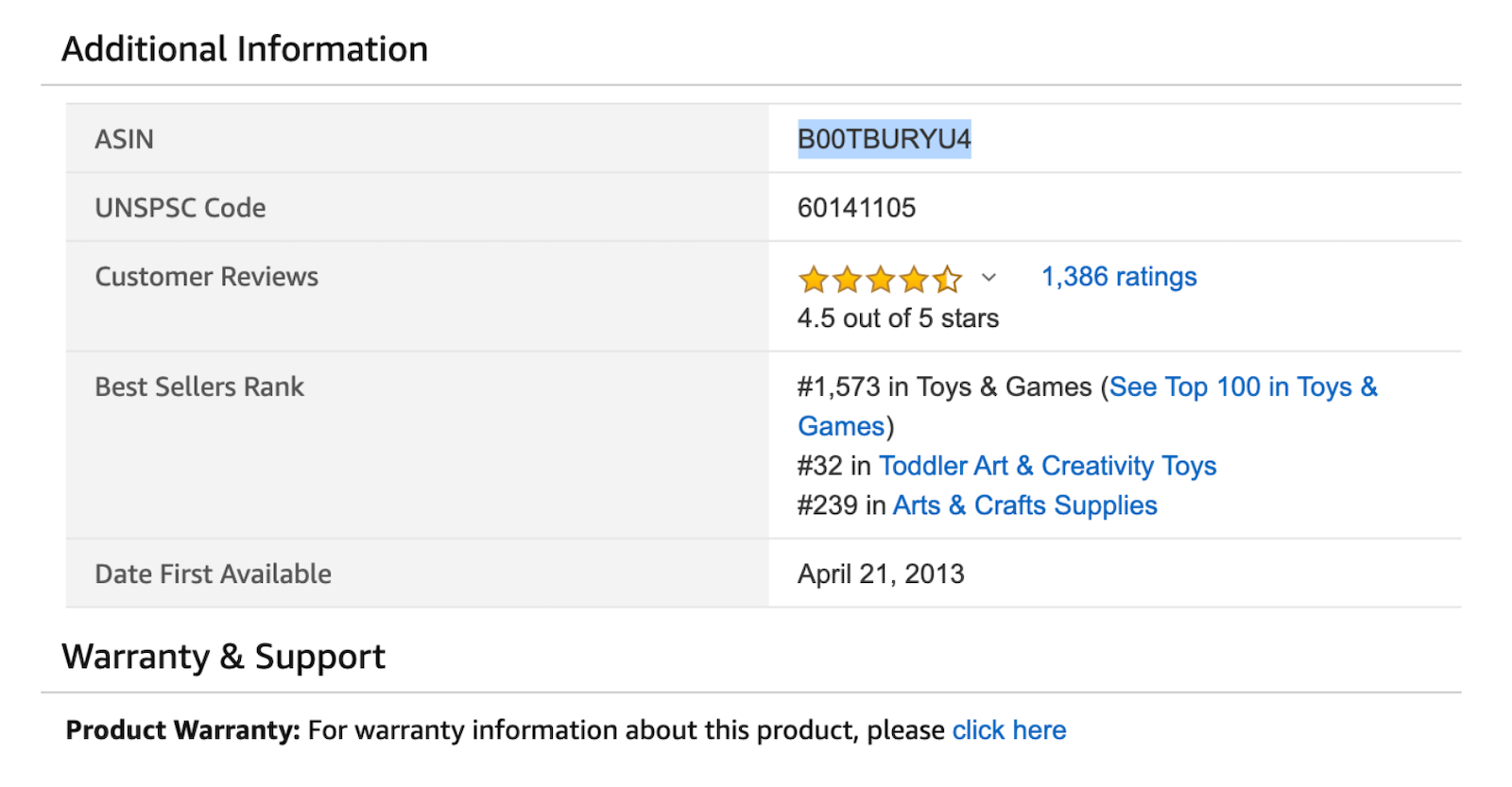
In Seller Central, go to Inventory > Add a product and paste the ASIN. You can also search for it in this section.
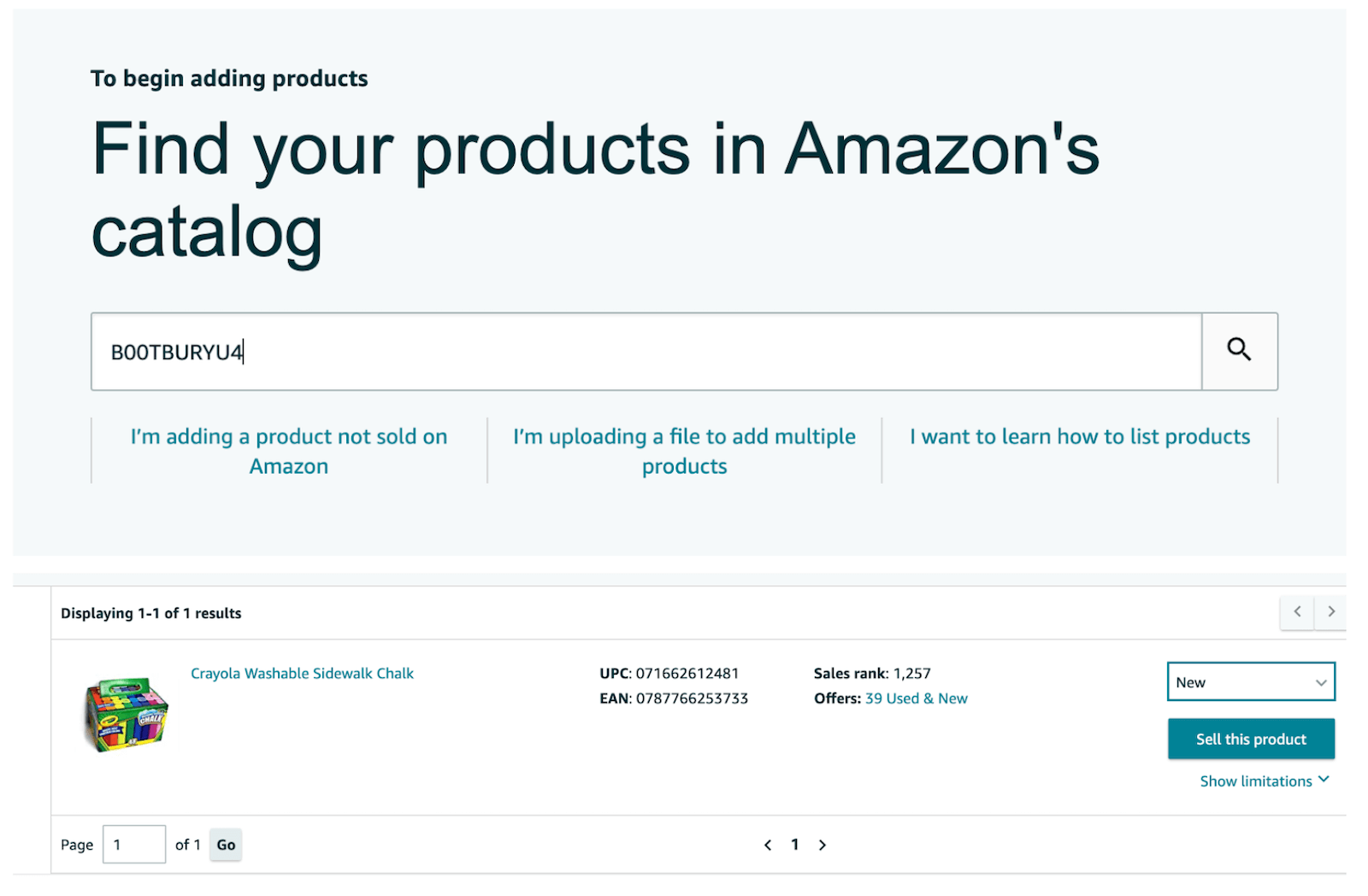
Choose “New” as the condition and select “Sell this product.”
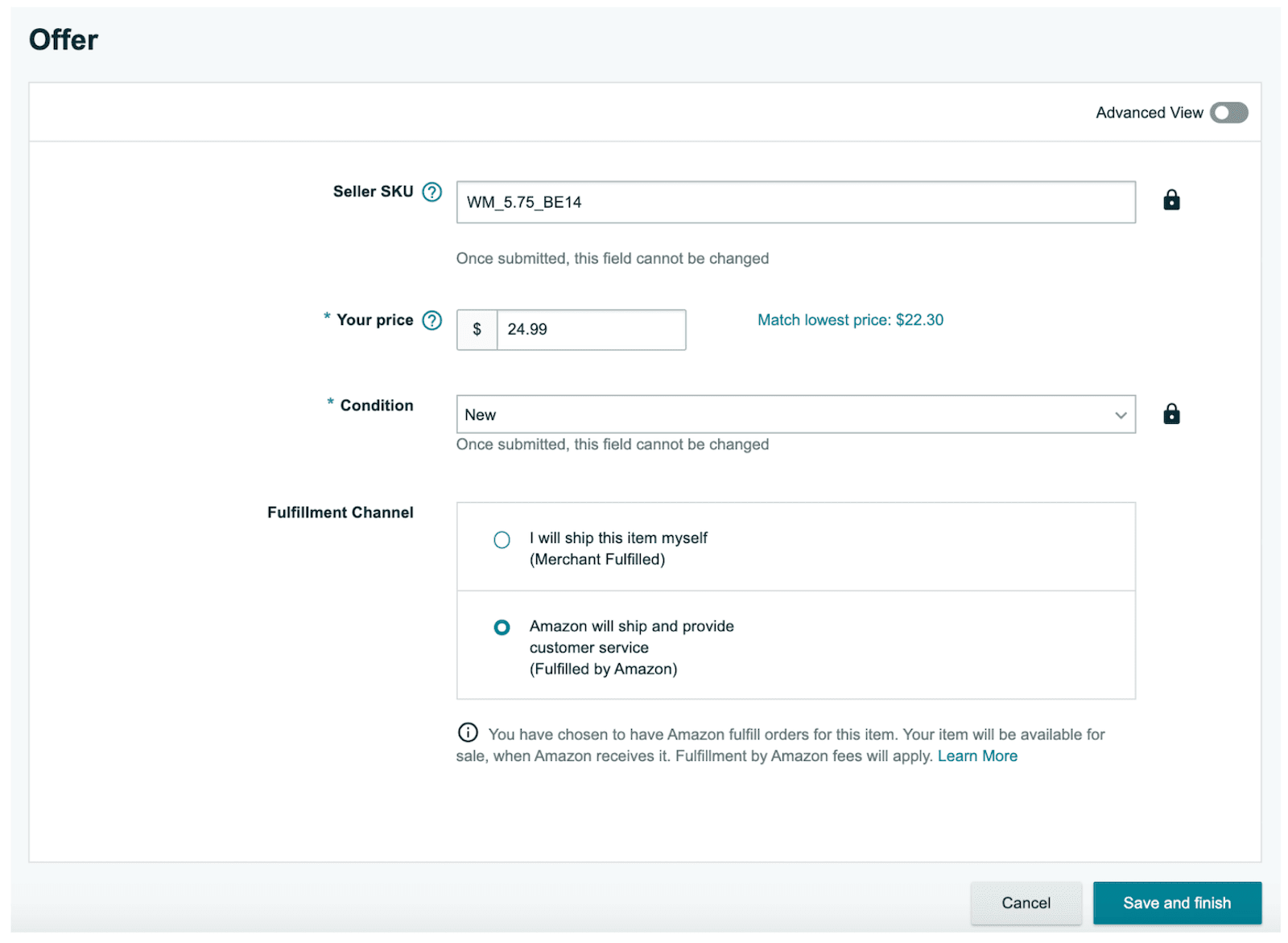
Once you hit “Save and finish,” Amazon will create a listing within your Manage Inventory page. Give it 15 minutes or so to show up and then you can create a shipment.

This is what you will see in your Manage Inventory. The status will show as “Inactive” because you do not yet have any inventory at Amazon’s warehouse.
How to create your FBA shipment
Now that you purchased inventory and added the listing within Seller Central, it is time to send in your inventory! You are one step closer to reselling products on Amazon.
Step 1: Find your product in Manage Inventory
On the far right, you will see “Edit” and a drop-down menu. Click the drop-down arrow and choose “Send/Replenish Inventory.”
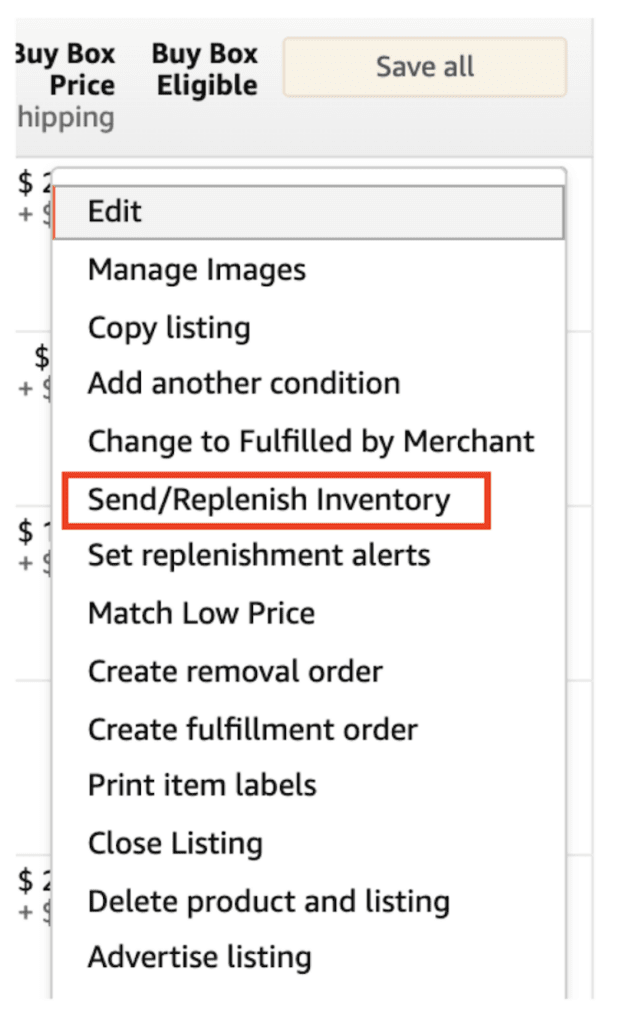
Step 2: Choose inventory to send
Here is where you will edit the packing template which consists of template name, how many units per box, dimensions, weight, and prep needed.
Then choose how many boxes you will be sending to Amazon.

In this example, we are sending 1 box filled with 20 units. Click “Confirm and continue.”
Step 3: Confirm shipping
In this section you will set your ship date, shipping mode (between “small parcel” or “less than truckload” you will choose small parcel), and then confirm the inbound shipping price. Since you added in the weight and dimensions in the previous section, there is not much else to do here.
When using Amazon’s partnered carrier (UPS), you will receive extremely low shipping rates. For this example, my 15 pound shipment will only cost $8.69 to ship into FBA.
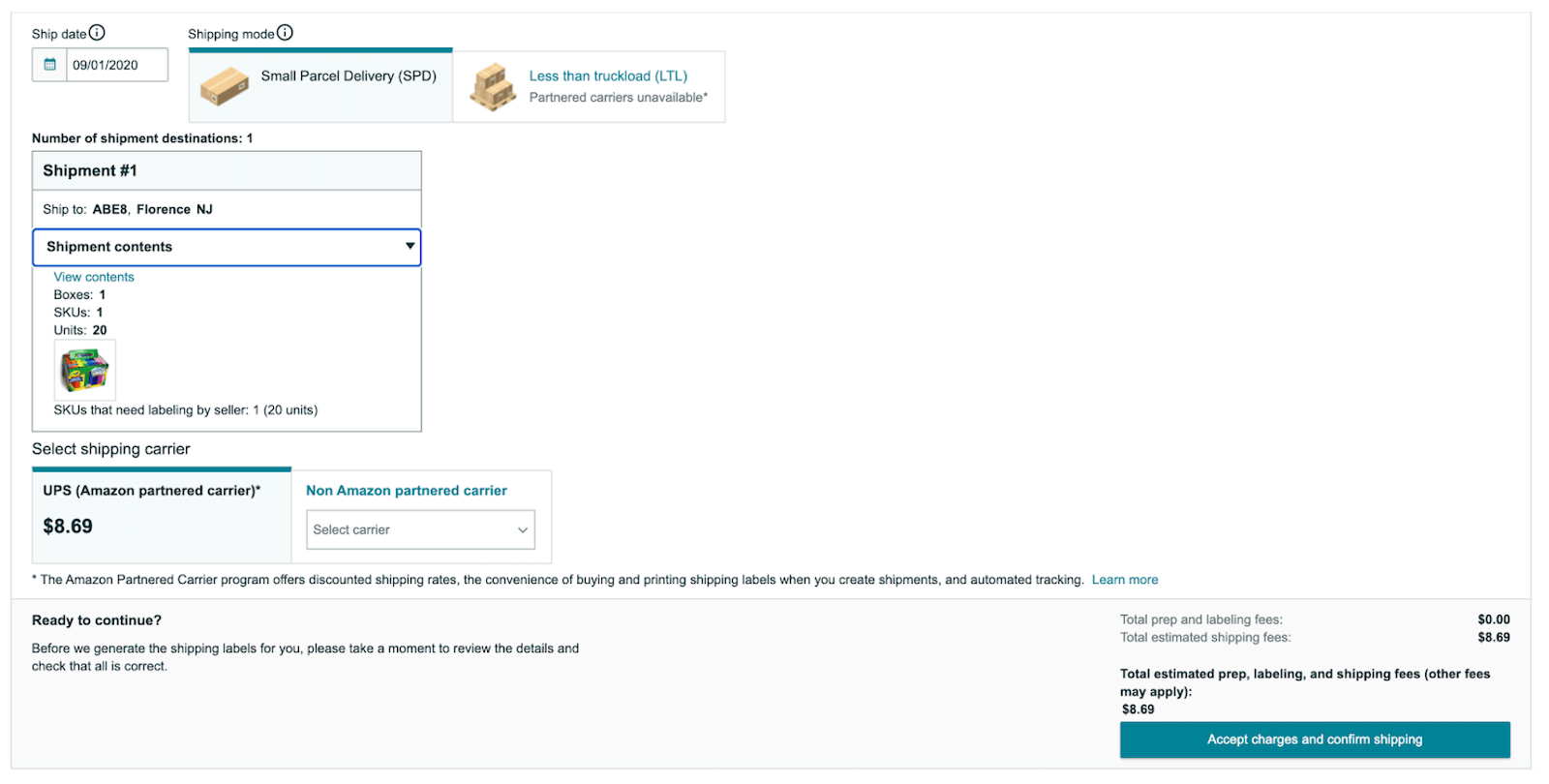
If you agree to these terms, click “Accept charges and confirm shipping.”
Step 4: Print FBA labels
Now that your shipment is confirmed, all you need to do is print your FBA label and affix it to your box. You will see two barcodes on the label. Make sure both of the labels are visible on the outside of your box. The first is the UPS label and the second is how Amazon will identify who the shipment is from and what is in your box.
READ MORE | How to Ship Directly to Amazon FBA
Monitor retail arbitrage sales and repeat!
You are now on your way to becoming a retail arbitrage seller on Amazon!
Using the Amazon Seller app, you will be able to monitor your daily sales, manage orders, as well as adjust pricing if needed. If you see your products are beginning to sell really well, work on finding more inventory so you can continue making sales.
If your products are not selling as well as you thought, make some pricing adjustments to drive more sales. Remember, format your SKU so you always know what you paid for it!
The key to success in a reselling business is to constantly be hustling and looking for new products. If you enjoy the hustle and going from store to store, then retail arbitrage may be the right business model for you.
Get out there and find some products!
If you have more questions related to retail arbitrage, let us know in the comments!
Interested in the Extension for your retail arbitrage research? Click the link below to learn more about Jungle Scout.
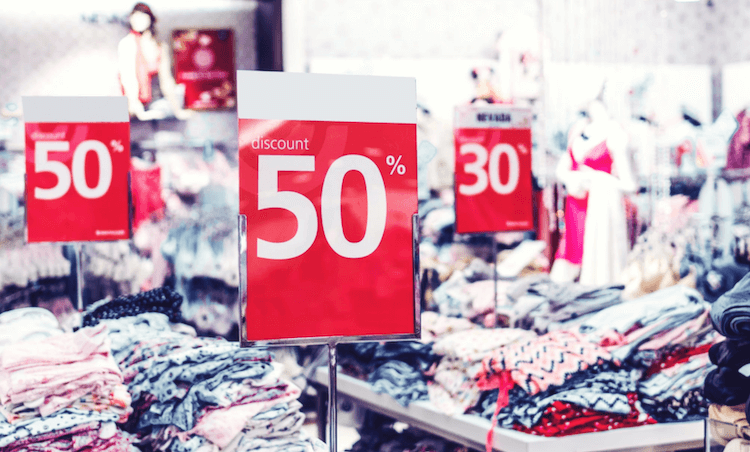
 156 Comments
156 Comments
156 comments on “Amazon Retail Arbitrage 2024 Guide”